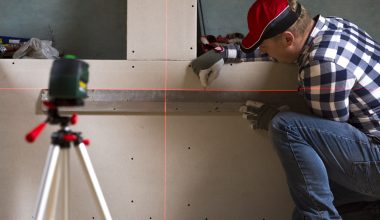Winter is coming… Or, maybe where you live, winter is already here! The weather doesn’t stop some from having to work on projects in their shop. Whether it’s woodworking, auto mechanic, or other DIY projects, having a warm workshop makes everything more bearable.
Most garages or workshops as-is are not made to be kept warm. Most of these tips help you with your current workshop, but some are ways you can insulate a workshop while you are in the process of building one.
Whatever your situation, don’t let the cold stop you! Read on to gather some tips to stay plenty warm in your workshop when it’s frigid outside.
6 Ways to Stay Warm in a Workshop
1. Bundle Up
When you don’t have time or resources to do any of the other tips below, first bundle up and grab all your cold-weather clothes to keep warm in the workshop.
Wool socks with boots will keep your feet nice and toasty. Put on some long johns and heavy-duty, lined overalls for warmth from chest to toe. Layer up even more with a sweater and winter coat (one that you don’t mind getting dirty). Finally, find some good gloves that you can work in to avoid frostbite and top your head off with a nice, warm hat.
2. Keep the Drafts Out
The first step to insulating your workshop or garage will be to find all the spots that have holes, exposing the interior to the outside elements, and dropping the temperature inside. Check the doors, garage doors, and windows all around your shop.
For doors, check the gaskets on the bottom. With age and exposure to heat and cold, these become less effective and brittle, given enough time. It’s a good idea to replace these gaskets if they are more than a few years old. Measure the bottom of your door and order a new one according to the size of your door.
Look along the sides of your garage door or standard door. Does the door completely seal? If not, you can buy some special weather-strip seal to apply around the perimeter of your door or garage door.
Another thing to check is the windows. Seeing any cracks that shouldn’t be there? You can buy and apply some shrink film to the interior surface of the window and use a hairdryer to shrink it to fit, keeping all those cold breezes out and the warm air in.
3. Warm your Workshop with An Infrared Electric Heaters
With added insulation from the other steps, buying a heater could certainly keep your workshop or garage as comfortable as the inside of your home. There are many kinds of infrared and electric heaters on the market today that could warm your workshop for you.
There are portable electric heaters that you simply place on the floor, plug into the wall and they heat right away. These heaters offer a fast solution but may be too small to efficiently heat your entire workshop space. That’s where wall-hanging electric heaters come in. These mount on to your ceiling and are temperature controlled by a remote and/or thermostat.
Measure the square footage of your workshop, then determine if the mounting heater you are looking at is powerful enough to heat the space. You might have to install more than one.
One downside to this heating method is the potential for the floor area to remain cold. This is problematic if you are laying under a car or other machinery most of the time. In this case, you can install a baseboard heater if that suits your needs best.
4. Finish the Walls with Insulation
Getting your workshop warm and keeping it that way will require lining the walls with insulation. Most garage spaces only consist of the studs used to construct the building and outer walls with siding. This is not very insulating, which means if you heat the space, the hot air will quickly leech outside and cold air will come back in, rendering your heating efforts worthless!
Add insulation to your workshop by purchasing some fiberglass batt insulation, adhering it to the wall, and finishing the wall with some drywall paneling. Finishing the walls completely is the best way to insulate your workshop walls, and will also lower your energy bills.
5. Insulate the Garage Door
If your workshop space includes a garage door, you will want to look into having that insulated too. Garages or workshops stay about 10 to 12 degrees warmer if their garage door is insulated, even without using any heaters.
Fortunately, this process is made incredibly easy with garage door insulation kits. All you need to do is measure your garage door and buy the proper-sized kit. Oversized doors might need two kits, so watch out for that detail.
6. Electric Blanket
Will you be crawling around on the floor in your workshop most of the time, and don’t want to spend the money on interior heating or insulation? A simple fix might be to purchase an electric blanket for you to lay on while you work. It will be best to find a cheap one new or a secondhand one, as it will get very dirty from being on the floor and from mechanical spills.
7. In-Floor Heating
For a complete renovation of a workshop or garage, it might be worth it to have some in-floor heating installed. This is especially true if you are going to be on the floor working on cars often.
Radiant floor heating, or in-floor heating, is a great way to add heat to your garage. However, it’s not something you can do yourself. This heating method should only be considered if you are revamping your old workshop and building a new one. You can hire someone to lay sand, a reflective layer, and pipes that will have hot water flowing through them under the concrete.
The in-floor heating installation will cost around $5-$9 per square foot of floor, plus the cost of your boiler to heat the water going through the pipes.
Conclusion
You can heat your garage the quick and easy way by plugging in an electric heater or adding warm layers to your outfit, or you can go the whole nine yards and insulate your walls, doors, and windows. Whatever is best for your situation, we hope we have helped you come up with some ideas on how to keep warm while working in your workshop. Now you will have no fear of the cold while working away all winter long.






